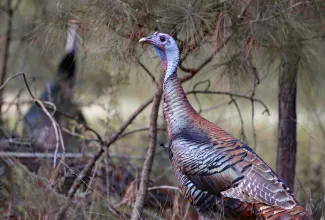
WILD TURKEY POPULATION DYNAMICS AND BROOD SURVIVAL PROJECT REPORT FOR JANUARY 2024
Provided by the Oklahoma Cooperative Fish and Wildlife Research Unit, Oklahoma State University
Wild turkey genetics, nesting success, and brood survival are among the research topics in a 4.5-year, $2 million study launched in 2022 by the Oklahoma Department of Wildlife Conservation, the Oklahoma Cooperative Fish and Wildlife Research Unit, with cooperation from the National Wild Turkey Federation, Turkeys for Tomorrow, and private landowners to address wild turkey population dynamics. Following is a summary of recent study activities.
SOUTHWESTERN OKLAHOMA POPULATION STUDY AREA:
Preparations for winter captures continued. Researchers began baiting and constructing traps at one site in Beckham County and one site in Harmon County. They also coordinated with cooperators in Custer County to begin baiting and monitoring future trap locations there. Data download from remaining hens from last year continued during January.
SOUTHEASTERN OKLAHOMA POPULATION STUDY AREA:
Preparations for winter captures continued. Researchers scouted and baited many different sites across McCurtain County and attempted captures on one mixed flock that was inconsistent on camera and only included three hens. Researchers reported three groups of hens seen on cameras visiting bait sites.
GENETICS STUDY:
Genomic data has been cleaned and quality-controlled for the initial 220 samples collected from the 2022 and 2023 seasons. For analyses, 163 samples from Oklahoma were selected and further separated into subspecies-specific datasets according to current ODWC designation of subspecies and hybrid zones by geographic location.
Initial data processing involved quality control steps to remove low-quality data, reduce errors, and facilitate reproducibility of results.
Preliminary analysis involved principal component analysis (PCA) to assess population structure across the dataset. As expected, the initial PCA showed separation between eastern and Rio Grande subspecies according to current ODWC designations. Individuals from the hybrid zone fell between these two clusters.
To further examine population structure, software was used to identify ancestry proportions of individuals across the dataset. Under the assumption of two ancestral populations, individuals from counties designated as Rio Grande and eastern subspecies showed low levels of mixture, with most individuals exhibiting genetics derived from their respective ancestors. However, individuals from the hybrid zone showed a much greater variation in mixture proportions.
While cross-validation provided evidence that a model with two ancestors was the best fit, a model with three ancestors showed some variation regarding current population structure. Under the assumption of three ancestral populations, individuals from the hybrid zone showed relatively little genetic influence from the eastern subspecies, while influence from the Rio Grande subspecies was prevalent in certain individuals. Relatively few individuals designated as eastern showed any Rio Grande ancestry, while many eastern individuals had 50% or greater mixture proportions derived from the third ancestor.
(Financial support for this publication was provided by the Oklahoma Department of Wildlife Conservation through the Wildlife Restoration Program, F21AF02702 [W-216-R-1] and Oklahoma State University.)